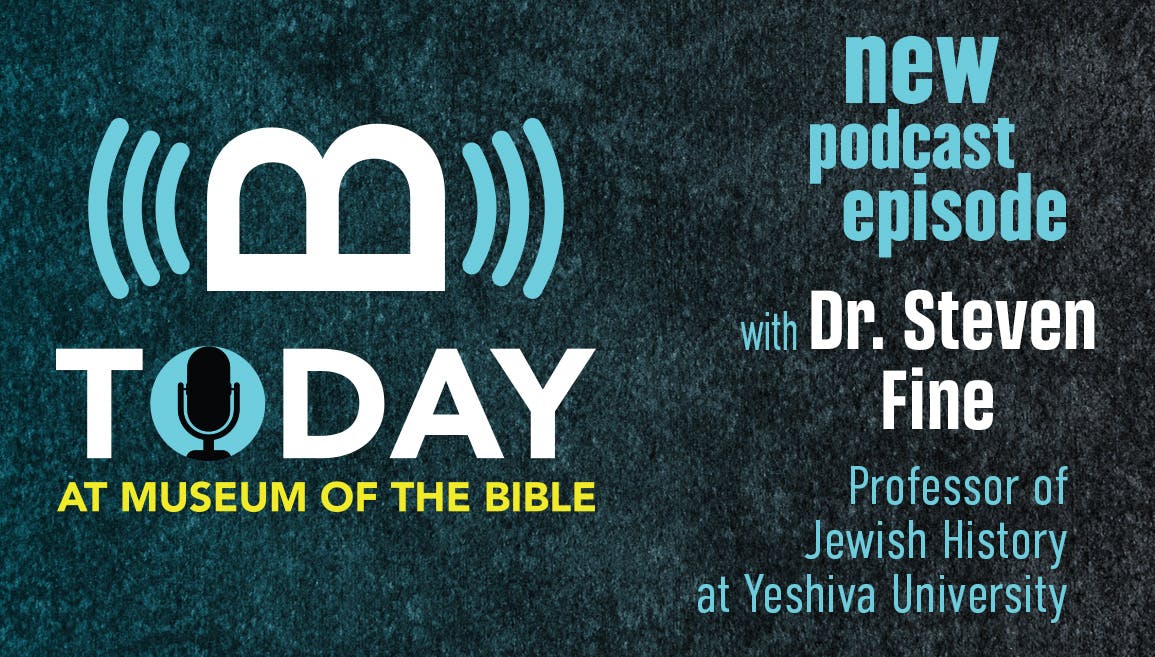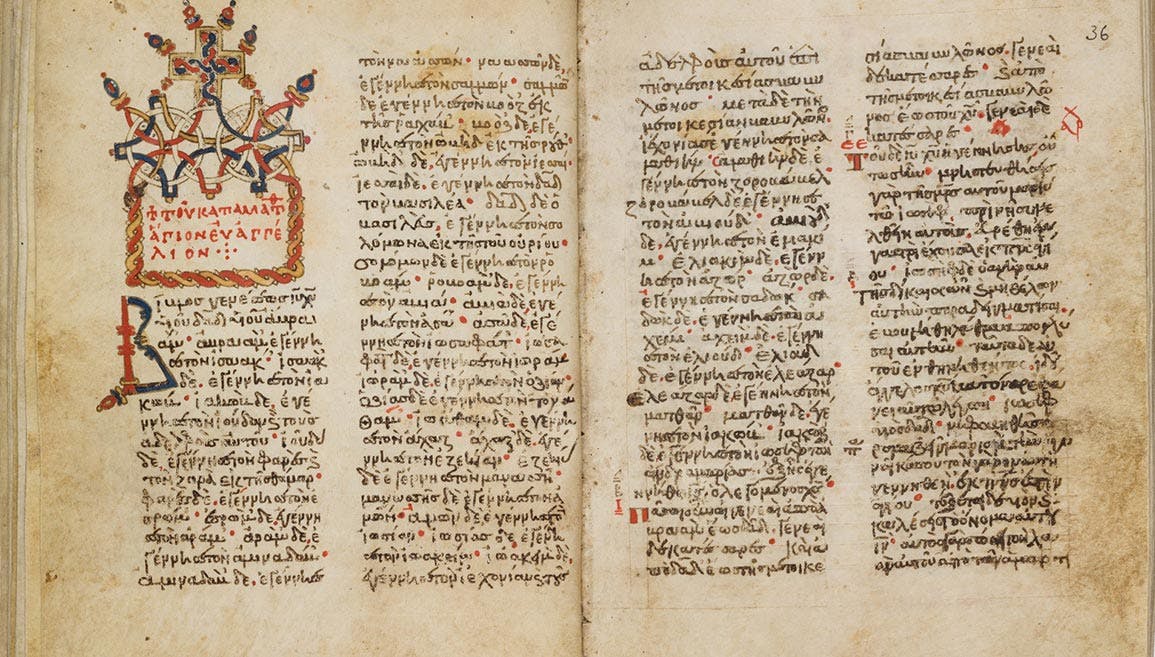From the Podcast: The Arch of Titus with Dr. Steven Fine

Recently on our podcast, Charlotte Clay, our director of Marketing and Communications, and Dr. Jeff Kloha, our chief curatorial officer, interviewed Dr. Steven Fine, director of the Center for Israel Studies at Yeshiva University, an expert in the history of Judaism and the lead curator for The Samaritans: A Biblical People, an exhibition featured at Museum of the Bible from September 16, 2022, to April 16, 2023.
The following interview has been edited for clarity and space. To listen to the whole interview, check it out here on our podcast or you can watch the episode on our YouTube channel.
Charlotte Clay: We're here with Dr. Stephen Fine of Yeshiva University, and he is going to tell us more about another area of expertise.
Jeff Kloha: Stephen, let's start with this. The temple was destroyed in AD 70 by the Romans. Why?
Steven Fine: Judaeans living in the pressure cooker of living in the Roman Empire developed different ways of dealing with Rome. There were those who were accommodating. There were those who were kind of accommodating, and there were those who would have nothing to do with it. There were those who spoke Greek, those who only spoke Aramaic, who didn't have the perception, I think, of how big Rome was and what it could do.
Jeff: Right, you have a global, dominant empire and it's affecting all aspects of culture and life. And do you want to play along or not?
Steven: And most people had the same problem. The difference between Jews and everyone else is people wrote about it and what they wrote existed. We don't know what the Gauls said about the Gauls, only what Julius Caesar said about them. We don't know what happened to the Phoenicians in North Africa, but they couldn't have liked it. But with Jews, we have a vast literature that's preserved either by Jews themselves in Talmudic literature or [that was preserved by Christians, like in] Josephus, the New Testament, and all sorts of places. And we know a lot because the destruction of the temple in Jerusalem served the Emperor Vespasian and his family like a glove. Vespasian took over at the end of what's called the Year of the Four Emperors 69 CE. Rome was a mess. The empire was falling apart. Vespasian came in and said, “I'm a nice guy. I come from mule herders. I'm a country guy. I'm a populist and you should like me.” And so, he did some amazing things. He tore down the emperor Nero’s pleasure garden and put up a theater that was as big as anyone had ever seen before, now called the Colosseum, the Flavian Amphitheater.
So, the Jewish War became the place where the Flavians could say, “Look what we've done. We destroyed barbarians and reestablished the peace of the empire.” They did what new empires do. They went around, as I said, building everywhere. And one of the things they built was this arch on the sacred way in Rome called the Arch of Titus, showing the parade that led and brought the spoils of Jerusalem into Rome.
Now this arch was a mess until the nineteenth century when it was rebuilt as an imperial model and became an imperial focal point, both for the church and for Napoleon, and for everybody else. That's why there are Arches of Titus all over the world. They're all over the world because it's such a nice clean architectural form and it always serves the same purpose. Something to pass through as a triumph. Within this arch, there was placed a series of bas reliefs that are very, very famous. One showed, as you mentioned before, the spoils of Jerusalem being carried into the city of Rome. The others showed Titus on his chariot with Victory over his shoulder in this parade now.
I've been fascinated by this thing about as long as I've been fascinated by anything. I wrote an Advanced Placement art history paper about this. I was in Istanbul, and I saw an exhibit there at the archaeology museum that showed a sarcophagus, which they said was the tomb of Alexander the Great, with paint on it and the reconstruction of it. I thought to myself, “Oh, that's cool.” And then I was at the Getty Museum, where there was a full exhibition about this, I thought, “Oh, that's interesting.” And I started finding sources and thinking about color and imagining what color was like. And then my friend Peter Schertz from the Virginia Museum calls me and said, “We're looking for color on the back of a statue of Caligula. You want to join the group?”
So, we're sitting and having breakfast, this group of archaeologists. At a moment where checking for color on Roman statues was still really cool and no one knew what a scanner was called. And we're having this conversation, and I said, “Do you think we could do the Arch of Titus?” And it just so happened that enough very powerful Italians were there. They were curious if the paint would survive.
So off we were to the Arch of Titus with the team that does the scanning. We scanned part of this panel of the Arch of Titus and also made a 3D scan of the entire panel, which is the basis of the exhibition that we did and then projected reproduced color on it. Now all we found was the yellow on the menorah. We had a one-time shot and believe it or not, a few bits of yellow on the menorah made international press.
It took some time, but it was clear to me that for whatever reasons, we weren't going to get back to Rome. Okay, what could we do with what we got? I sat with Donald Sanders and with my friend Peter from Virginia, and we started a project. Donald has this business that does 3D imaging of archaeological artifacts.
It was easy to colorize the menorah. We just add some color. But then we decided we could fix this. So, we fixed the menorah. After that, we said, “Oh, we could fix the table over there.” So, we fixed the table. Then we realized we only had one head on any of these statues. And once you look at it, the thing’s a mess; our eyes clean it up and make it more reasonable. Remember, we had this 3D scan, we took one head and put it on all the other heads so everybody had a head. Then we realized that this image is the same as this image, except this guy's fatter than that guy, and realized we began to know our images, and so we reproduced and fixed all the feet. And by the time we knew it, we'd done the whole silly thing.
Charlotte: You did an entire digital restoration.
Steven: We did it and we didn't plan to. And the question was, OK, we got the menorah, we got this other stuff. What color do we make this skin? Do we make it look like northern Europeans? Do we make it look like Mediterranean people? Obviously, we chose Mediterranean people. Then what color are the tunics? So we took Roman tunics. Then what kind of background could this be? Well, look at the Roman paintings. They use blue backgrounds. Okay, we'll use a blue background and so the whole thing ended up in color. And then we thought, “Oh my God, this is cool,” because it hadn't been done with that level of precision. So we did an exhibition at Yeshiva University Museum where we created this thing, but we weren't going to paint it and we weren't going to put all of the shading because we don't know what the shading was. We decided, and Donald came up with this, that we would project the reconstruction and then the color straight onto a full-size model. And that would create all the shadows, because the light would create the shadows, and they would be much more authentic to the original object. And so that's what we did. But what it allowed for was literally walking up to this panel and seeing it without funny glasses, in ways that it hadn't been seen before. And so that was the beginning, which became a whole project on the arch.
Charlotte: So, did the Met do this after you?
Steven: The Met has a wonderful exhibition which is sort of next generation color. The Germans who originally did the coloration that I'd seen in Istanbul, that I'd seen in Los Angeles . . . at first, everybody pooh poohed them because, after all, this stuff’s really white. We're so used to white, and somebody even attacked us in one of the magazines: How can you make, put color on the arches? You're taking away our beautiful white statues.
Modernism has this stuff about black and white and seriousness that Romans didn't have. And so, this— like Samaritans—is a place to sort of tilt a little bit and say, “Oh, that's different.” Let's think about ourselves in different ways. Which is ultimately what scholarship is supposed to be, I hope. An opportunity to think about our past through our present and figure out our future. That's what exhibition is about, right? That's what film is about when it's done by people who know what they're talking about. When academics do this stuff; we're not doing it to create a book in the library. I hope we're doing it to create a culture that we all can live in together and the amazing thing for me is, of course, that my Titus was on display at Museum of the Bible in an exhibition not so long ago in beautiful color. It came out beautifully. And it's because of that event that our Samaritan [exhibition] happened. And so, it's all for good, and people who came to the museum and saw that exhibition, which was organized by the Hebrew University, looked up and said, “Oh, that's what it looked like.”
Charlotte: It's literally eye-opening and very beautiful, even if it's garish.
Steven: It's really cool, yeah.
Charlotte: Well, thank you so much. This is fascinating. If you want to learn more, please visit museumoftheBible.org.
Steven: Thank you, everyone. Thank you.
Jeff: Thanks, Steven.


